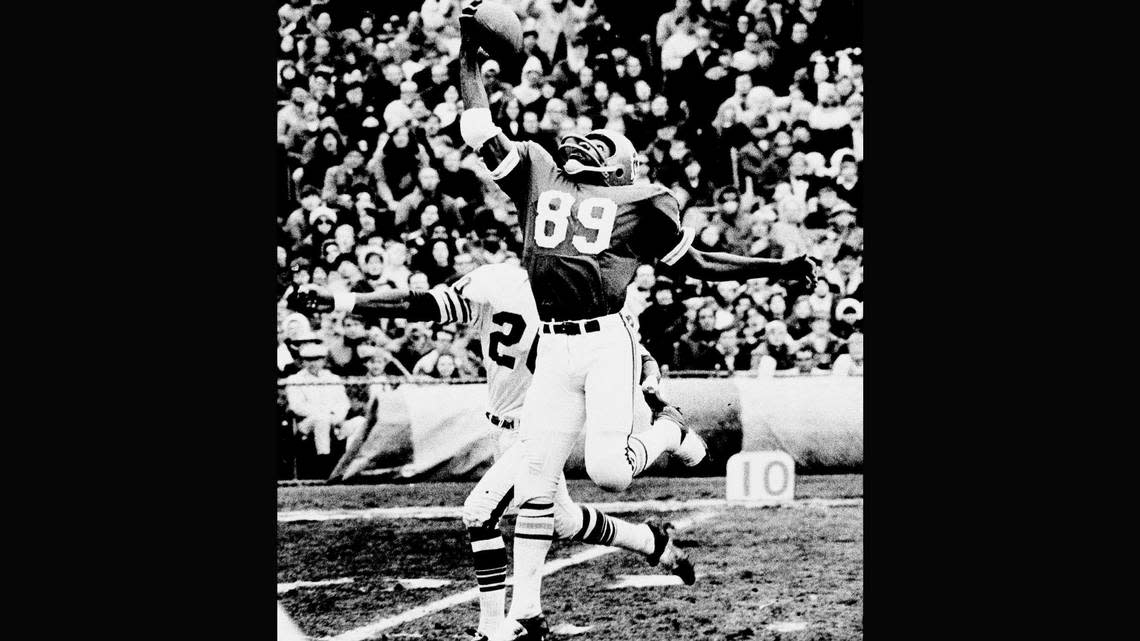Former Chiefs great Otis Taylor is a Pro Football Hall of Fame senior semifinalist

Going on decades now, Otis Taylor’s rich case to be enshrined in the Pro Football Hall of Fame had languished in the limbo of “the abyss” — the Hall of Fame senior committee’s frustrated nickname for the backlog of dozens of Hall-worthy stars of yesteryear, who have had little hope of receiving their due with only one a year eligible for induction.
Among other prominent former Chiefs who merit further consideration, including Ed Budde, Deron Cherry, Jim Tyrer, whose case may come to be looked upon differently as we learn more about the potential of CTE as a contributing factor in the shocking murder of his wife and subsequent suicide.
Along the way, even to many who played with and admired Taylor, it seemed his chance had passed.
To be sure, there remains far from an assurance that will change in the months ahead.
But Taylor on Thursday was named one of 25 semifinalists for the Hall’s Class of 2023 for what is now up to three senior spots, thanks to new PFHOF president Jim Porter embracing input from voters and engaging that annual expansion through the Class of 2025.
Taylor wasn’t the only influential force with the Chiefs to make a Hall of Fame semifinalist list on Thursday: Former coach Marty Schottenheimer and former president and general manager Carl Peterson were among 29 semifinalists in the Coach/Contributor category.
Also among those 29 is pioneering Chiefs scout Lloyd Wells — whose considerable accomplishments and exploits at the height of the old AFL-NFL jousting included luring Taylor away from so-called NFL babysitters out the back window of a Texas hotel with the enticement of a red Thunderbird awaiting him in Kansas City.
The Hall’s 12-person senior committee and coach/contributor committees will reduce each list to 12 finalists late this month and meet to select up to three players and one Coach/Contributor overall in August.
Each of those affiliated with the Chiefs have compelling cases.
But Taylor’s has been the most discussed for the longest time and has been made all the more poignant by the fact he’s been bedridden and unable to speak or engage for the better part of two decades.
Now he at least has a fresh and real chance.
What follows is a snippet of what we wrote last week about why we believe he belongs:
You can’t tell the story of pro football without the Chiefs of the late 1960s (not to mention the current version). And the story of those Chiefs, even those times in the evolution of the game, is entwined with Taylor.
So ... you can’t tell the story of pro football without Taylor’s multifaceted and momentous role, starting with the staggering eye test of a man who embodied the changing times in the nature of the game.
That included being at the heart of those AFL-NFL battles and, in fact, part of the AFL competing with the NFL at a crucial juncture.
When he signed with the Chiefs, that was the beginning of Taylor being part of a pivot point at several notable crossroads.
Amid a groundswell of civil rights activism, for instance, his signing reflected a socially significant movement by the Chiefs and owner Lamar Hunt to recruit African-American players, including from Historically Black Colleges and Universities … with the considerable help of Wells.
That pioneering mindset led to the 1969 team becoming the first in the history of pro football to have more than 50% of its starters be Black. That emphasis even accounted for some meaningful progress in race relations and social change in Kansas City, albeit haphazardly, as Bobby Bell’s endless house-hunting testified.
Most visibly, Taylor became instrumental in the Chiefs’ surge to two of the first four Super Bowls as the AFL compelled the merger with the NFL, punctuated by the team’s Super Bowl IV victory over Minnesota.
As great as the Chiefs of that time were, Taylor was indispensable.
“At that time, I was desperately looking for a new dimension for our receiving,” legendary coach Hank Stram told The Star in 1971. “When I saw Otis, I knew I had it.”
He also had the prototype, even forerunner, of the modern receiver. Nevermind that his statistics by today’s standards aren’t glitzy: He had 410 receptions for 7,308 yards and 57 touchdowns in an 11-season career.
That was in an era when the regular season was 14 games and the passing game still was largely a subordinate of the running game, even for a forward-thinking team like Stram’s Chiefs.
By way of example, Len Dawson threw 188 passes in eight career postseason games (23.5 a game); Patrick Mahomes has thrown 423 in 11 (an average of 38.5).
As my friend and eminent author Michael MacCambridge put it in his book, “‘69 Chiefs, A Team, A Season, And The Birth of Modern Kansas City,” Taylor was “the focal point, the one player on the offense who could be, in the coach’s parlance, a ‘difference-maker.’ His body and skills were like a message from the future.”
So here we are now in a future in which we can hope anew that Taylor gets properly recognized at last.
The 25 senior semifinalists: Ken Anderson, Maxie Baughan, Mark Clayton, Roger Craig, LaVern Dilweg, Randy Gradishar, Lester Hayes, Chris Hinton, Chuck Howley, Cecil Isbell, Joe Jacoby, Billie “White Shoes” Johnson, Mike Kenn, Joe Klecko, Bob Kuechenberg, George Kunz, Jim Marshall, Clay Matthews Jr., Eddie Meador, Stanley Morgan, Tommy Nobis, Ken Riley, Sterling Sharpe, Otis Taylor and Everson Walls.
The 29 Coach/Contributor semifinalists: K.S. “Bud” Adams Jr., Roone Arledge, C.O. Brocato, Don Coryell, Otho Davis, Ralph Hay, Mike Holmgren, Frank “Bucko” Kilroy, Eddie Kotal, Robert Kraft, Rich McKay, John McVay, Art Modell, Clint Murchison Jr., Buddy Parker, Carl Peterson, Dan Reeves, Lee Remmel, Art Rooney Jr., Marty Schottenheimer, Jerry Seeman, Mike Shanahan, Clark Shaughnessy, Seymour Siwoff, Amy Trask, Jim Tunney, Jack Vainisi, Lloyd Wells and John Wooten.
